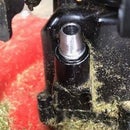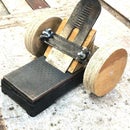Introduction: Drilling Jig for Making the Wooden Centrifugal Puzzle
Making this puzzle requires some fairly accurate drilling into the end of the pieces. I thought I would make only one or two of these puzzles, but they have become very popular and I have been making quite a few of them to give to friends. You may want to click on the link above to acquaint yourself with how the puzzle is made so that this Instructable has more of a context.
Step 1: Drilling
This was the setup I used. I mounted a drill chuck on the 1/2" x 20 thread arbor at one end of my radial arm saw's motor shaft. There are two problems. First, the motor speed is 3,000 rpm. That is really too fast for my twist drill bit. It heats up when doing a lot of drilling and drilling is slower than it would be at a slower speed. Second, I do not want to disturb my setup, so my saw is tied up and unavailable for other uses.
Also, I found I can go to Lowe's or Home Depot and buy ready-made 5/8" x 5/8" square dowels. Using them saves a lot of time over making my own square stock. The drilling jig shown in this Instructable is made to accept 5/8" x 5/8" square dowels. They work very well for making these wooden puzzles.
Step 2: Special Drilling Jig
I decided to make this special drilling jig for use with a handheld electric drill. I began by welding two pieces of steel bar to make a 90 degree corner. I needed a crisp internal corner. Angle iron off of the shelf usually has a rounded internal corner. When I welded these pieces together, the hot welding beads contracted and the corner was suddenly greater than 90 degrees. I used a hammer and a vise to bring the angle of the corner back to 90 degrees.
Step 3: Custom Sleeve
I needed a metal sleeve to guide the drill bit. What is known in the USA as a 1/4 inch pipe nipple worked very well. It is a bit larger internally than 1/4 inch in diameter. I drilled it out to 19/64 of an inch, which is the size of hole I am using for the dowels in the wooden puzzle.
Step 4: Place the Nipple for Welding
I had already drilled some parts for a puzzle by using my radial arm saw drilling setup pictured in step 1. The photo for this step shows the welding completed. To do the alignment for welding, place the nipple sleeve onto the drill bit. Insert the drill bit into the pre-drilled wooden puzzle part. Lay the wooden puzzle part into the angle welded up in step 2.
See the second illustration for this step. It shows the nipple sleeve in its place with two short pieces of steel rod filling the space between the nipple and the angle. Weld a bead where you see the lime green. This is to be a precision guide, but welding always causes things to move when the weld bead cools. Making these welds first reduces the movement that can take place.
See the third illustration for this step. Make tack welds shown in dark blue to secure the nipple in place. (If the nipple is galvinized, remove the zinc coating before welding.) The rods limit any possible movement on the pipe when the weld beads cool.
Step 5: End Stop
I welded a scrap of round rod across the bottom end of my welding jig to act as a positioning stop.
Step 6: To Use
Cut the square stock to length. Insert it in the angle of the jig. Insert the drill bit into the nipple sleeve. Drill to the required depth. Remove the drill. Tap and blow sawdust from the hole.
This little jig makes producing the wooden puzzles much faster. My holes are not perfectly aligned on center, but are close enough that the puzzles work very well. The jig will last long enough to make quite a few of these puzzles.
In the second photo with this step you can see I used an engraver to label the jig so I will always know what it is and why I am saving it.













